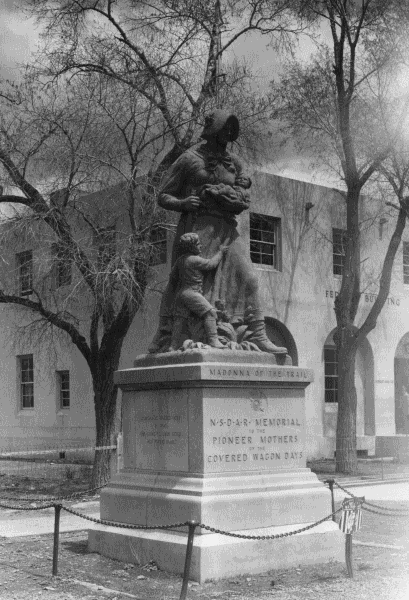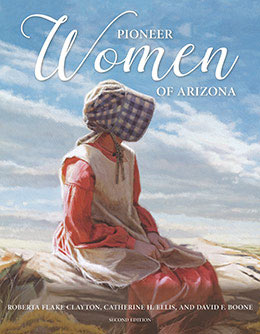Preface
Catherine H. Ellis and David F. Boone
Catherine H. Ellis and David F. Boone, "Preface," in Pioneer Women of Arizona, ed. Roberta Flake Clayton, Catherine H. Ellis, and David F. Boone (Religious Studies Center, Brigham Young University; Salt Lake City: Deseret Book, 2017), xvi-xviii.
 Pioneers Monuments: Madonna of the Trail. In 1928, the Daughters of the American Revolution placed twelve identical statues along the National Old Trails Road, from Bethesda, Maryland, to Upland, California. These statues hnoored "the Pioneer Mothers of the Covered Wagon Days" and were created by sculptor August Leimnbach. Each was 18 feet high and made of poured algonite stone. Inscriptions on the east and west sides of the base are standard, but the inscriptions on the north and south reflect local history. The two inscriptions on the Springerville statue read, "Coronado passed here in 1540. He came to seek gold but found fame," and "A tribute to the pioneers of Arizona and the Southwest who trod this ground and braved the dangers of the Apaches and other warrior tribes." At the dedication of the monument, Governor George W. P. Hunt carefully noted the contribution of all pioneer women:
Pioneers Monuments: Madonna of the Trail. In 1928, the Daughters of the American Revolution placed twelve identical statues along the National Old Trails Road, from Bethesda, Maryland, to Upland, California. These statues hnoored "the Pioneer Mothers of the Covered Wagon Days" and were created by sculptor August Leimnbach. Each was 18 feet high and made of poured algonite stone. Inscriptions on the east and west sides of the base are standard, but the inscriptions on the north and south reflect local history. The two inscriptions on the Springerville statue read, "Coronado passed here in 1540. He came to seek gold but found fame," and "A tribute to the pioneers of Arizona and the Southwest who trod this ground and braved the dangers of the Apaches and other warrior tribes." At the dedication of the monument, Governor George W. P. Hunt carefully noted the contribution of all pioneer women:
Prior to this time we have given recognition to the pioneers of our State in various ways. But the tendency has been too much to recognize and give praise to the men who formed the vanguard of that wave of white immigration, which reclaimed Arizona from the wilderness, and to overlook and minimize the very valuable and essential part played in the settlement of our State by the women folk. Their sacrifice was necessarily greater than that of their men. They forsook all the comforts and refinements of home, which women hold particularly dear, in order to follow their men in the search for new lands and new homes in the West. Theirs was a faith and loyalty beyond all measure. We of Arizona owe the greater debt of gratitude to the pioneer women, in the measure that theirs was the greater sacrifice.
Perhaps to men among the pioneers should go the larger credit for conquering and subduing the wilderness. But to the pioneer women fell the more important task of refining civilizing the new human society which sprang up there.
Governor Hunt then recognized the Mormon women whose "descendants . . . are living today in this beautiful valley," the "waves of Spanish-American immigrants," and the cattle barons of Texas. he said, "With each succeeding wave of white immigration into this section of the Southwest came the women folk, marching bravely beside their men, giving them faith, hope and comfort."
On July 10, 1969, reporter Mitzi Zipf of Mesa wrote in the Sun Valley Spur-Shopper, “Pioneer Mormon women who followed their men into the vast unknown of the West to the Great Salt Lake, and into Arizona and other parts of the West were made of a metal which today would be difficult to match.” Zipf was describing women whose biographies had just been made available in the new book, Pioneer Women of Arizona, produced by ninety-two-year-old Roberta Flake Clayton. Clayton herself wrote that she had spent thirty-three years compiling these sketches. The 719-page book was never typeset, was never copyrighted, and contained no photographs. It simply had a blue plastic cover with the title in yellow letters held together with a glued mesh spine and medium blue tape. Today, copies of this book are in major libraries and some homes, but Pioneer Women of Arizona is almost entirely unavailable for purchase at any price.
Important in either reprinting or producing a new edition of Pioneer Women of Arizona is the issue of copyright. In a 1973 oral history interview with Sue Abbey, Clayton said that after her book was published, W. Earl Merrill of Mesa visited and asked to use some of the information in his weekly newspaper columns. She said, “Well, my material is not on copyright, and . . . I want everybody to know about the hardships and the courage of those women, and so you’re welcome to anything I have written. The only thing I ask is that you give the source from which it came.”
Before the advent of photocopy machines, histories of ancestors were copied and recopied by hand. Errors were introduced, information was deleted either accidentally or intentionally, original documents were not consulted, and much of the information was second hand or had been transmitted orally. In some cases, two nearly identical sketches are listed with different authors and have variations even in the direct quotes. All of these problems mean that reprinting Pioneer Women of Arizona is not historically warranted as it originally stood, except that it is still used by historians and family members alike. Further, we believe that this new edition, with explanatory footnotes, corrections, an updated bibliography, a general history of colonization in Arizona, and an appendix listing Mormon settlements and maps will be a benefit to family members and a useful addition to Arizona history libraries and Mormon collections.
This edition of PWA had two separate beginnings. In early 2011, Ellis began discussing the life of RFC (and the possibility of republishing PWA) with D. L. Turner. Later when Turner was busy finishing her thesis, they found that David F. Boone had already begun to work on this project and had the entire original book on disk. After some discussion in the spring of 2013, it seemed that an Ellis and Boone partnership was the best way to finish the project. We appreciate Turner’s stimulating friendship and her coauthorship on the biographical sketch for RFC. It should be noted, however, that changes and additions included in this edition are those of Ellis and Boone.
We wish to express our deep appreciation to all who have helped with this project, particularly, Charles S. Peterson, who not only pioneered sound historical research in Arizona’s Mormon communities but has encouraged similar research by others. A second major thank-you should go to all people who worked on compiling centennial pioneer histories in the 1980s; sometimes these were stake histories and sometimes town histories, but people such as Wanda LaBaron, W. Earl Merrill, Bess Erickson, Josie B. Tenney, LeRoy and Mabel Wilhelm, and others have given historians and posterity an invaluable resource. After correcting errors in PWA sketches and adding footnotes, we tried to let descendants and other interested persons look over the sketches before publishing. Occasionally changes or additions were suggested. Those who helped include Jo Baeza, Dilworth Brinton Jr., Shirley Cole, Sybil Corry, Kent H. Dalton, Keith Eagar, David H. Ellis, Kevin Folkman, Pat Fuentes, Norman Gardner, Q. Marion Hansen, Jo Ann Hatch, Kathi Hausmann, Richard and Carma Heywood, Roma Lee Hiatt, Steve Houghton, Brenda Johnson, Lucille Brewer Kempton, Jeaneane Klefsky, Diane Kriter, Dennis Lancaster, Ralph Lancaster, Scott Lee, Cornelia “Nena” Brown LeSueur, Darrel LeSueur, Fred and Sherryl Martin, Joyce and Loren McRae, Kenneth and Marie Noble, Arvin Palmer, Laurel Hunt Pedersen, Craig Reay, Marti Roe, Christine Schweikart, Wanda Turley Smith, Jim Snitzer, Nada Spurgeon, D. L. Turner, Lois Waterman, LaVerl Wilhelm, and Alice Wood. Chaille McGrew, an adult convert to the Church and therefore someone with no Mormon pioneer ancestry, read the entire manuscript looking for typographical errors and sentences that simply did not make sense. We express our appreciation to Bruce Dinges, editor of the Journal of Arizona History, for permission to use portions of Ellis’s article “‘Arizona Has Been Good to Me’: Routes and Recollections of Latter-day Saint Settlement in Arizona” in the Migration and Settlement section.
We are grateful to all who have provided photographs, which add a great deal to the book; attributions are listed at the end of each caption. Every effort was made to locate actual photographs posted at FamilySearch.org, both for permission to publish and to obtain larger scans. These were used only as a last resort and only after checking with FamilySearch.org personnel. Thanks to Thomas A. Wayment and Joany Pinegar of the Religious Studies Center for guiding the initial review process. We owe a huge debt of gratitude to two anonymous reviewers who were not only willing to tackle a manuscript this size but offered substantial, helpful comments. We are particularly grateful to Hyrum F. Boone for creating the extensive index for this volume. We appreciate the editing help of Allyson Jones (project lead from Mesa), Hadley Griggs (from Phoenix), Shannon Mills Taylor (Snowflake), Lauren Whitby (from Phoenix), Kimball Gardner, Tyler Balli, Leah Welker, and Devan Jensen. Finally, thanks for the expert design work of Madison Swapp and Brent R. Nordgren.
Librarians and archivists at several institutions were also extremely helpful. These include numerous people at the Church History Library in Salt Lake City, Melanie Sturgeon (Arizona State Libraries, Archives, and Public Records), Karina Wilhelm (Map and Geospatial Hub, Arizona State University Library), Shari Brimhall (Stinson Museum, Snowflake), Becky Gibson (Smith Memorial Home, Snowflake), Carmen Shumway (Taylor Museum), Linda Richardson (St. Johns Family History Library), Hal Herbert (Graham County Historical Society), Clair Thomas (Show Low Historical Society), JoLynn Fox (Navajo County Historical Society, Holbrook), Edres Barney (Eastern Arizona Museum and Historical Society, Pima), and Sue Kartchner (St. David Historical Society). Unfortunately, the Mesa Family History Library, with its extensive collection of information about Mormon families in Arizona, closed in 2014, remained closed all of 2015, and is not scheduled to reopen anytime soon. This means that Clayton’s original manuscripts could not be consulted (beyond what we looked at early in the project) and a few other references could not be completed. We apologize in behalf of the library for the inconvenience this will cause to some readers.
As noted in the table of contents, this edition of PWA is divided into three parts. Part 1 provides introductory material for the entire book. Part 2 contains the biographical sketches rearranged in alphabetical order by last name. Part 3 is an assessment of the sketches as a whole. The original book, Pioneer Women of Arizona, was a monumental undertaking for Roberta Flake Clayton. We hope that she would be pleased with this revised edition.
Catherine H. Ellis and David F. Boone
